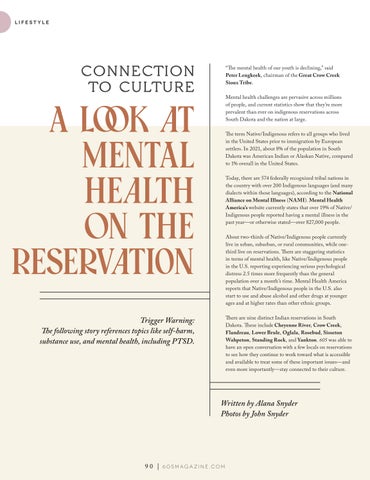LIFESTYLE
CONNECTION TO CULTURE
“The mental health of our youth is declining,” said Peter Lengkeek, chairman of the Great Crow Creek Sioux Tribe. Mental health challenges are pervasive across millions of people, and current statistics show that they’re more prevalent than ever on indigenous reservations across South Dakota and the nation at large.
A LOOK AT MENTAL HEALTH ON THE RESERVATION
The term Native/Indigenous refers to all groups who lived in the United States prior to immigration by European settlers. In 2021, about 8% of the population in South Dakota was American Indian or Alaskan Native, compared to 1% overall in the United States. Today, there are 574 federally recognized tribal nations in the country with over 200 Indigenous languages (and many dialects within those languages), according to the National Alliance on Mental Illness (NAMI). Mental Health America’s website currently states that over 19% of Native/ Indigenous people reported having a mental illness in the past year—or otherwise stated—over 827,000 people. About two-thirds of Native/Indigenous people currently live in urban, suburban, or rural communities, while onethird live on reservations. There are staggering statistics in terms of mental health, like Native/Indigenous people in the U.S. reporting experiencing serious psychological distress 2.5 times more frequently than the general population over a month’s time. Mental Health America reports that Native/Indigenous people in the U.S. also start to use and abuse alcohol and other drugs at younger ages and at higher rates than other ethnic groups. There are nine distinct Indian reservations in South Dakota. These include Cheyenne River, Crow Creek, Flandreau, Lower Brule, Oglala, Rosebud, Sisseton Wahpeton, Standing Rock, and Yankton. 605 was able to have an open conversation with a few locals on reservations to see how they continue to work toward what is accessible and available to treat some of these important issues—and even more importantly—stay connected to their culture.
Trigger Warning: The following story references topics like self-harm, substance use, and mental health, including PTSD.
Written by Alana Snyder Photos by John Snyder
9 0 | 605MAGAZINE.COM
